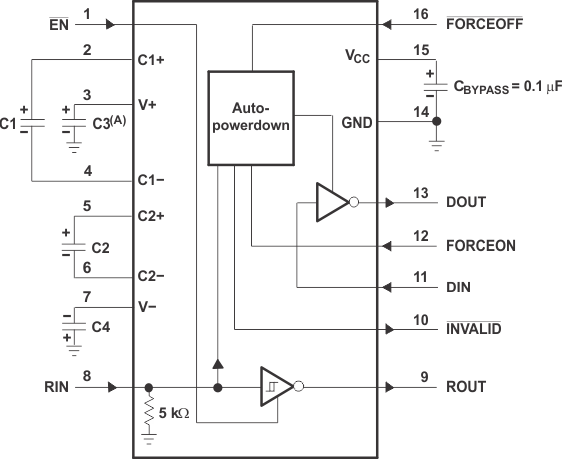ZHCSO02C July 2007 – December 2024 TRSF3221E
PRODUCTION DATA
- 1
- 1 特性
- 2 应用
- 3 说明
- 4 Pin Configuration and Functions
-
5 Specifications
- 5.1 Absolute Maximum Ratings
- 5.2 ESD Ratings
- 5.3 ESD Ratings, IEC Specifications
- 5.4 Recommended Operating Conditions
- 5.5 Thermal Resistance Characteristics
- 5.6 Electrical Characteristics
- 5.7 Electrical Characteristics, Driver
- 5.8 Switching Characteristics, Driver
- 5.9 Electrical Characteristics, Receiver
- 5.10 Switching Characteristics, Receiver
- 5.11 Electrical Characteristics, Auto-Powerdown
- 5.12 Switching Characteristics, Auto-Powerdown
- 5.13 Typical Characteristics
- 6 Parameter Measurement Information
- 7 Detailed Description
- 8 Application and Implementation
- 9 Device and Documentation Support
- 10Revision History
- 11Mechanical, Packaging, and Orderable Information
封装选项
机械数据 (封装 | 引脚)
散热焊盘机械数据 (封装 | 引脚)
- RGT|16
订购信息
8.1.1 Typical Application
ROUT and DIN connect to UART or general purpose logic lines. FORCEON and FORCEOFFmay be connected general purpose logic lines or tied to ground or VCC. INVALID may be connected to a general purpose logic line or left unconnected. RIN and DOUT lines connect to a RS-232 connector or cable. DIN, FORCEON, and FORCEOFF inputs must not be left unconnected.

| VCC | C1 | C2, C3, C4 | ||
|---|---|---|---|---|
| 3.3V ± 0.3V | 0.1µF | 0.1µF | ||
| 5V ± 0.5V | 0.047µF | 0.33µF | ||
| 3V to 5.5V | 0.1µF | 0.47µF | ||